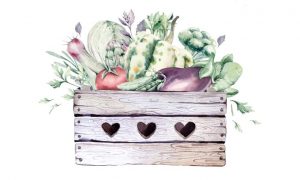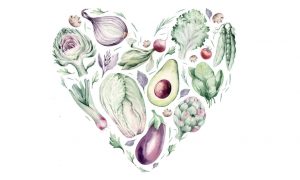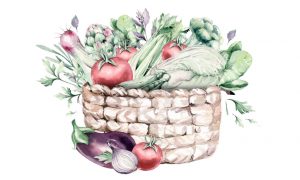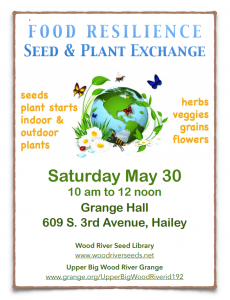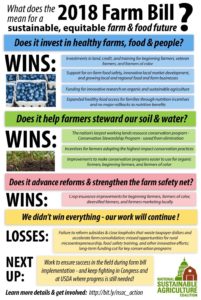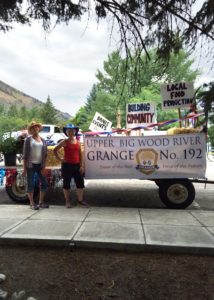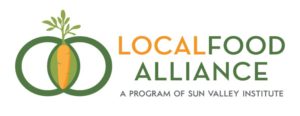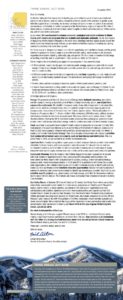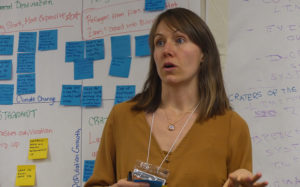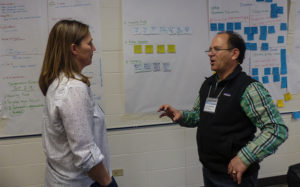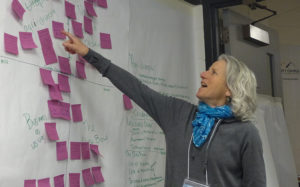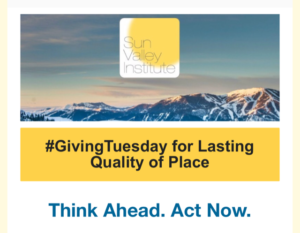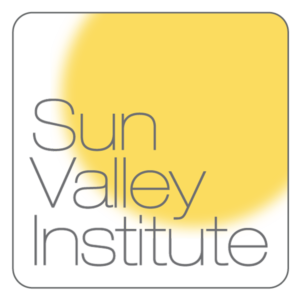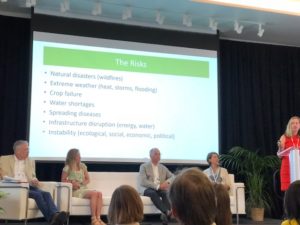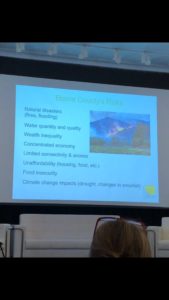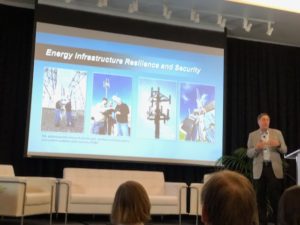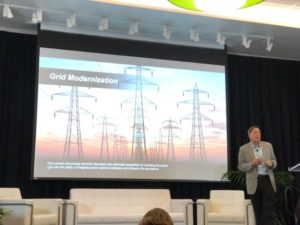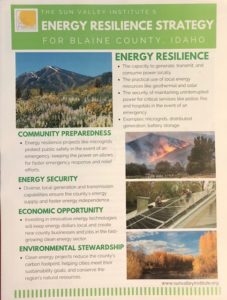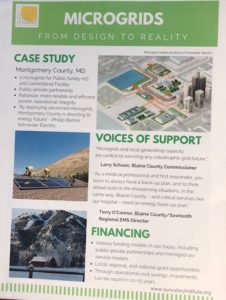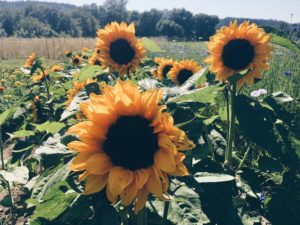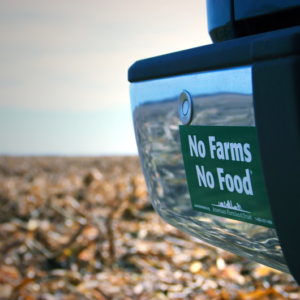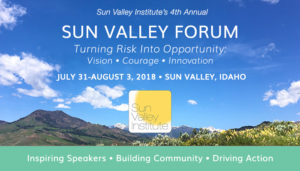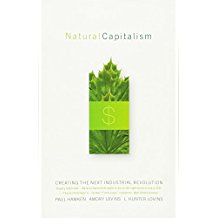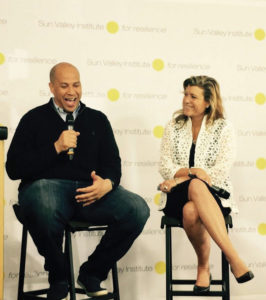Sun Valley Institute
Sharing sustenance.
May 12, 2020Instead of Buying Guns or Hoarding Food, Let’s Feed Each Other
YES! Magazine/Solutions Journalism
by Michele Bigley
From my patio in Santa Cruz, California, I watched a scrub jay deliver a peanut shell to its oak-tree home. My neighbor hollered hello from the street below, explaining that she was afraid to go to the store for groceries. “A person was held at gunpoint at the Target,” she said. “Everyone’s going crazy.”
My grandparents had “war gardens” in the 1940s, and small, potted remnants from that time took root on their patios well into their golden years. I’d often asked them to teach me how to grow veggies. But they argued that because grocery store shelves were fully stocked again, they didn’t think it was necessary to teach me how to put in the work of growing my own food.
Yet now our local farms have waiting lists for their Community Supported Agriculture weekly deliveries.
We can plant seeds that take a little weight off our overburdened food system and grocery store workers.
Inspired by all this generosity, I wanted to go beyond simply planting a victory garden for my family’s sustenance. I wanted the sustenance to be shared, so I sent out a blast on Nextdoor.com. Within minutes, people offered up compost bins, some more seeds and soil, starter pots. My septuagenarian neighbors brought over tools, advice, and veggie starts. Another guy I didn’t even know was scavenging scrap wood from a construction site nearby; when I asked about how to make a garden bed, he lugged over some wood, and constructed one in my yard.
The retired crisis therapist across the street noticed the raised bed and said, “In the news, we’re seeing the worst of humanity right now, but around us we’re experiencing extreme acts of kindness, too.”
Many Americans have been raised with this ethos of individualism. I, too, was taught to take care of my family above all else. With the threats of joblessness and hunger in every community, I get that urge to protect what’s ours, especially when we’re terrified that a stranger’s cough can land us in the ICU.
But in the 1930s and 1940s, 20 million Americans stepped up in a time of great global terror. They planted gardens in abandoned lots, on patios, and on rooftops. Today, too, we have the potential to shift how we engage with our world. In fact, social distancing requires it. We can broaden our perspectives and open our hearts to people with whom we might share nothing more than proximity. They will be the ones there for us in crisis. They will deliver chicken soup if we’re sick. They will check in on us if they don’t see us out and about. And they will let us know when the grocery store finally has some Clorox wipes.
Now six weeks into our shelter-in-place, the spinach and strawberries, tomatoes and kale, cucumbers and peppers are sprouting. When I called my neighbor to revel in these tiny green victories, she told me to look on my front stoop. There, I found a pack of toilet paper
Blaine County IDAHO Local Food Alliance
sunvalleyinstitute.org
DIGITAL FOOD GUIDE
Help us connect you with farms and ranches, farmers markets, and restaurants serving locally grown food! The new print version of our 2020 Wood River Valley Locally Grown Guide will hit local magazine stands, visitors’ centers and other regional venues in a matter of days. Now, we are updating our online food guide to include all the same business and non-profit listings, visuals and links, so community members and visitors can find local food with a few simple clicks.
$1 billion per page.
January 9, 2019“On December 20, DT signed the Agricultural Improvement Act of 2018 (commonly knows as the Farm Bill) into law. The bill, projected to cost $28 billion over the next five years, is one of the largest spending packages in the country, doling out money for low-income nutrition assistance, crop insurance, commodity subsidies and conservation programs, among other things. Learn more about the triumphs and failures of the new farm bill from Marion Nestle on Food Politics and Dan Imhoff on Civil Eats.” -Local Food Alliance
The bill takes up 807 pages, with a table of contents of 11 pages. It will cost taxpayers $867 billion over ten years. That’s more than $1 billion per page.
by Marion Nestle
SNAP
Recall that more than 75% of Farm Bill expenditures go for SNAP—The Supplemental Nutrition Assistance Program (formerly Food Stamps).
The “bipartisan win”? Attempts to cut SNAP expenditures and introduce work requirements failed to pass (whew), although Congress is still working on ways to cut enrollments.
Commodity payments
The bill allows payments to more distant relatives of farm owners—cousins, nieces, nephews—a gift to the already rich. Payments can still go to those earning more than $900,000 a year in adjusted gross income (sigh).
Organics
The bill authorizes $395 million in research funding over the next 10 years, and small amounts for data collection, offset of certification costs, and technology upgrades. But the bill weakens restrictions on chemicals that can be used in organic production.
Hemp
The bill grants $2 million a year for support of hemp as a crop, and authorizes USDA to study the economic viability of its domestic production and sale. It also authorizes Indian tribes (that’s the term the bill uses) to grow hemp.
Cuba
The bill allows funding for USDA trade promotion programs in Cuba.
The Managers recognize that expanding trade with Cuba not only represents an opportunity for American farmers and ranchers, but also a chance to improve engagement with the Cuban people in support of democratic ideas and human rights…The Managers expect that the Secretary will work closely with eligible trade organizations to educate them about allowable activities to improve exports to Cuba under the Market Access and Foreign Market Development Cooperator Programs.
https://www.foodpolitics.com/2018/12/the-2018-farm-bill-more-of-the-same-old-same-old/
https://civileats.com/2018/12/13/despite-small-wins-the-new-farm-bill-is-a-failure-of-imagination/
JOIN THE GRANGE
Founded in 1924, Upper Big Wood River Grange, aka the Hailey Grange, is a nonprofit, nonpartisan, fraternal organization that advocates for rural America and agriculture. It also is home to the Wood River Seed Library’s Seed Vault. Learn about becoming a member at the Grange’s January 17 Meeting and Annual New Member Drive – 7:15-8:45pm, at Grange Hall, 609 South 3rd Ave. in Hailey. Guest speaker Aimée Christensen, founder and executive director of Sun Valley Institute, will talk about resiliency and food-related risks and opportunities before us.
SVI 
December 20, 2018 Sun Valley Institute, “advancing economic, and social resilience in Blaine County with models and programs that are scalable and replicable nationally.”
Blaine County Community Resilience Workshop: Climate Change
December 6, 2018Aimee Christensen led a group looking at energy scenarios.
Journalist Karen Bossick published an in-depth exposé today [12.6] on Blaine County’s 1st Community Resilience Workshop. Our valley is the first in Idaho to begin planning for climate changes and the effects those changes will, and are, having in our community, e.g., wild fires, energy sources, food, jobs, and housing. Blaine County Commissioner Larry Schoen: “We’re setting the stage not only for our own action but for other communities to follow our lead.” A second workshop is scheduled for February to begin pursuing concrete actions. The workshop was initiated by the Blaine County Commissioners and organized by the Sun Valley Institute.
Eye On Sun Valley, Story & Photos by Karen Bossick
Brittany Skelton, senior planner for the City of Ketchum, addresses such scenarios where the county might have to kick squatters out of national forest land.
Sawtooth National Forest official Bobbi Filbert and Blaine County Commissioner Jacob Greenberg discuss possible scenarios involving climate refugees.
Hailey City Council Member Kaz Thea points out the need for increased agricultural diversity in the Wood River Valley.
“We’re traveling 10 years into the future so we can move from fear and concern into hope and action,” said Amber Bieg, a facilitator with the Boise-based Warm Springs Consulting.
Blaine’s future.
November 27, 2018
|
|
|
|
|
SVI: Where Convention and Opportunity Meet
August 7, 2018
Walter Starke:
“The spiritualization of our nation’s corporations is the most important development that can possible happen of the spiritual growth of the world as a whole.
Changing Climate/Climate Change
Visuals from the Sun Valley Forum
RISKS
OPPORTUNITIES
Mark Peters, Director, Idaho National Laboratory (INL)
‘The Idaho National Laboratory’s mission includes discovering, demonstrating and securing innovative clean energy options and critical infrastructure, making it a test bed and model for resilience innovation serving national security, including grid and cyber security and micrograms.’
https://www.inl.gov/article/grid-resilience/
“Last fall, Idaho National Laboratory researchers assembled a coalition of partners to design a system of microgrids that would enhance grid resilience by maintaining and restoring power after a catastrophic event or a cyberattack.
During the coming months, the partners will demonstrate this technology in the small fishing village of Cordova, Alaska.
When the microgrid system is finished, Cordova’s electrical grid will automatically reroute power to ensure that critical public services — hospitals, emergency shelters and other vital services — have electricity if part of the grid is damaged or disabled.”
“Microgrids and local generating capacity are central to surviving any catastrophic grid failure.” -Larry Schoen, Blaine county Commissioner
“As a medical professional and first responder, you learn to always have a back-up plan, and to think ahead even in life-threatening situations. In the same way, blaine county–and critical services like our hospital–need an energy back-up plan.” -Terry O’Connor, Blaine county/Sawtooth Regional EMS Director
SVI: Where Convention and Opportunity Meet
August 4, 2018Climate change, our changing climate, is not a political ideology. It is reality. The Sun Valley Forum created and organized by the Sun Valley Institute focused on risk and opportunity for our new reality over three days this past week. Continue to check this space for synthesis, integration, and action.
“The global food system is the number one water consumer, is a major source of greenhouse gas emissions, and threatens coastal ecosystems with nutrient-loads from fertilizers. At the same time, the food system faces major risks from drought, soil loss, and heat. A regenerative, climate-smart food system has the potential to sequester carbon, reduce water consumption and pollution, increase the nutrients in our food, and make it more resilient to heat and drought. Across consumer engagement, investment, and market development, we are sharing the innovative technologies,strategies, and good solutions being implemented local and globally.”
Victor Friedberg, Co-found S2G and Founder, Good Shot Global
Alex Mackay, Director of Business Development & Investor Relations, Iroquois Valley Farms
To feed 10 billion people by 2050: http://www.foodshot.org
Iroquois Valley Farmland REIT is a restorative farmland finance company providing land access to organic family farmers, with a focus on the next generation. Starting in 2007 (through Iroquois Valley Farms LLC) and establishing itself as a leader in socially responsible investing before “SRI” and “Impact Investing” were common vernacular, the Company has a long track record of successfully acquiring organic and transitional farmland. In 2016, the Company expanded its scope to include first mortgage financing.
The Company raises private capital from accredited investor sources including IRA’s, family offices, financial advisors, foundations, and socially responsible investment-related funds. Investors are broadly based and encompass over 40 states and countries. These investments facilitate farmers’ expansion plans through leasing or mortgage financing. Iroquois Valley Farmland REIT was established as a Public Benefit Corporation, whose public benefit is enabling healthy food production, soil restoration and water quality improvement through the establishment of secure and sustainable farmland access tenures.
“We built our business to support the businesses of our farmers.” David Miller, Co-Founder and CEO
“Organic family farmers with land access.”
NPR
Which Vision of farming is better for the planet?
by Paul Chisholm
Along the back of this field of sugar snap peas, sunflowers and bachelor buttons at Oxbow Farm & Conservation Center is a buffer of maturing big-leaf maples and red-osier dogwoods. It’s a combination of forest and thicket that the farm has left standing to help protect water quality in the river and aquifer.
[Oxbow Farm & Conservation Center]
Farmers face a growing dilemma. Specifically, a food-growing dilemma.
How do you feed an increasing number of people without harming the environment?
As it turns out, growing as much food as possible in a small area may be our best bet for sustainably feeding the world’s population, according to new research.
[…]
Matt Distler is an ecologist with Oxbow Farm & Conservation Center, which sits on a 243-acre mosaic of organic farmland, wetland, and forest east of Seattle. Distler’s job is to balance food production against environmental concerns.
For Distler, the results are interesting, but they might not change the way they do things at Oxbow. That’s because their decisions are based on a lot of different environmental considerations, and carbon storage is only one of them.
“Certainly, the question of carbon is in the back of our minds,” says Distler. “But we’re focused a bit more on the conservation of biodiversity.”
American Farmland Trust (AFT) began in 1980 after a small group of farmers and conservationists asked an important question: What will happen to the nation’s food supply if we continue to wastefully develop our best farm and ranch land?
In Texas — the heart of Trump country — the city of Georgetown runs on 100% renewable energy. Republican Mayor Dale Ross told Axios that the decision was “a no-brainer economically.”
“If you win the economic argument you’re going to win the environmental argument.”
Why it matters: President Trump and many Republican leaders are rolling back environmental measures related to climate change. But in Georgetown, “We put these silly national partisan politics aside,” said Ross. Climate change is one of the most divisive political topics, but cities like Georgetown are finding that renewable energy sources like hydropower, wind and solar may provide more financial stability than fossil fuels.” -Republican Mayor Dale Ross
SVI: Where Convention and Opportunity Meet
August 3, 2018Initial takeaways from the 2018 Sun Valley Forum:
Re-invent impact.
The media promotes crazy extremes; the changing climate is not a political ideology.
Time is imperative.
“Stop thinking in silos.” -Julie Wrigley
407
Climate Mayors — the national coalition of 407 U.S. Mayors dedicated to pursuing solutions to global warming — denounces this unprecedented attack on both the environment and states’ rights, and vows to continue moving forward on transportation policies that help reduce the impact of climate pollution.
“I promise to leave the world better than I found it.”
The authors of Natural Capitalism say that these choices are possible and such an economy would offer a stunning new set of opportunities for all of society, amounting to no less than the next industrial revolution. The book has many practical suggestions for companies interested in a sustainable future.
According to the authors, the “next industrial revolution” depends on the espousal of four central strategies: “the conservation of resources through more effective manufacturing processes, the reuse of materials as found in natural systems, a change in values from quantity to quality, and investing in natural capital, or restoring and sustaining natural resources.
We win or die by our culture; we are everyday change makers.
#ClimateOptimist
The Climate Optimist Manifesto:
“I believe we can solve climate change.
I will shine a light on solutions, share my optimism & take positive action.”
“There isn’t enough hope–we have to keep hope alive”
“Martin Luther King didn’t say, ‘I have a nightmare.’ He said, ‘I have a dream.'”
BlessedTomorrow.org
Climate Change Mitigation and Advocacy in 2018 and Beyond
by Anita Fete Crews
6.14.18
On May 2, Blessed Tomorrow and Auburn Seminary co-hosted the 2018 National Climate and Faith Leadership Forum, a gathering of nearly 50 faith leaders exploring how to increase climate change mitigation and advocacy activities across the country. Participants represented a diverse group of faith institutions and faith-based organizations, shared best practices, and discussed how to catalyze new, bolder, and broader efforts such as committing to 100% clean energy. Faith organizations and leaders are increasingly adopting climate change as a top priority, and embracing care for God’s creation as part of their faith identity and moral responsibility.
http://blessedtomorrow.org/blog/climate-change-mitigation-and-advocacy-2018-and-beyond
“Vote with your fork.” -Ali Long
“Local Food Alliance…is on and pushing the leading edge of dynamic social and economic changes that are increasingly important in an ever-widening circle of acceptance.” – Larry Schoen, Blaine County Commissioner
Senator Cory Booker (D) spoke with Founding Executive Director Aimee Christensen at the first Sun Valley Forum four years ago. On Friday, August 2nd, at the Netroots National Annual Conference he shared:
“No matter how powerful corporate greed and corporations might be getting, the power of the people is greater than the people in power.”
And this gives us hope.
[More from the forum soon–check this space.]
